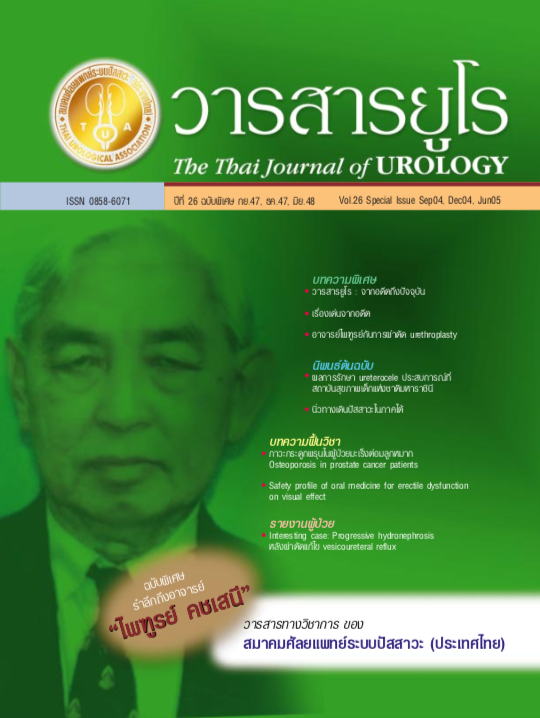The outcome of ureterocele management at Queen Sirikit National Institute of Child Health
Keywords:
outcome, ureterocele, managementAbstract
Objective: To evaluate the result of surgical management of ureterocele by various techniques at Queen Sirikit National Institute of Child Health.
Material and methods: The records of all children with ureterocele who underwent surgery at Queen Sirikit National Institute of Child Health between 1999 to 2003 were reviewed. Age, sex, number of renal system, presenting symptoms, imaging, and operative techniques were analysed.
Results: There were 25 cases (26 renal units), 19 girls and 6 boys .Five cases (25%),6 renal units, had single system which one boy had bilateral ureterocele and 20 cases (75%)were duplex system. Mean age at first operation was 24.9 months (range between 11 days to 6 years), 14 cases were under 12 months. Presenting symptom were recurrent UTI (92%), abnor- mal urination (16%), abnormal mass (12%), failure to thrive (8%), prolapsed ureterocele (4%), abdominal pain (4%) and antenatal hydronephrosis (4%). Patients were divided into 3 groups according to types of surgery. Group A, 15 cases (60%) underwent transurethral incision (TUI), 4 cases were success after first TUI, 3 cases needed second TUI and another 8 cases needed second operations; 7 excision of ureterocele and reimplantation and 1 nephrectomy due to nonfunction single system. The mean time between the first and second operation was 12 months (range 3-26 months). Group B, 7 cases underwent upper pole heminephrectomy alone and 1 needed excision of ureterocele and common sheath reimplantation due to high grade reflux of the lower moiety ureter. Group C, 2 cases underwent excision of ureterocele and reimplantation in which one boy had bilateral single system and another one was duplex and high grade reflux of both system.
Conclusion: Transurethral incision of ureterocele is the treatment of choice for decom- pression of the obstructed hydroureters in both single or duplex system, especially for infancy and younger child and had 47% (7/15) success rate by TUI alone in this study. The second operation is needed in complicated cases especially who has multiple lower tract anomalies.
References
Cooper CS, Passerini-Glazel G, Hutcheson JC, et al. Long-term follow up of endoscopic incision of ureteroceles: intravesical versus extravesical. J Urol 2000; 164(3 Pt 2): 1097-9.
De Jong, Tom PVM, Dik Pieter, et al. Ectopic ureterocele: results of open surgical therapy in 40 patients. J Urol 2000; 164(6): 2040- 4.
DeFoor W, Minevich E, Tackett L, Yasar U, Wacksman J, Sheldon C. Ectopic ureterocele: clinical application of classification based on renal unit jeopardy. J Urol 2003; 169(3): 1092-4.
Husmann DA, Strand WR, Ewalt DH, Kramer SA. Is endoscopic decompression of the neonatal extravesical upper pole ureterocele necessary for prevention of urinary tract infections or bladder neck obstruction? J Urol 2002; 167(3): 1440-2.
Singh SJ, Smith G. Effectiveness of primary endoscopic incision of ureteroceles. Pediatr Surg Int 2001; 17(7): 528-31.
Hagg MJ, Mourachov PV, Snyder HM, et al. The modern endoscopic approach to ureterocele. J Urol 2000; 163(3): 940-3.
Chertin B, Fridmans A, Hadas-Halpren I, Farkas A. Endoscopic puncture of ureterocele as a minimally invasive and effective long- term procedure in children. Eur Urol 2001; 39(3): 332-6.
Chertin B, De Caluwe D, Puri P.Is primary endoscopic puncture of ureterocele a long-term effective procedure? J Pediatr Surg 2003; 38(1): 116-9.



